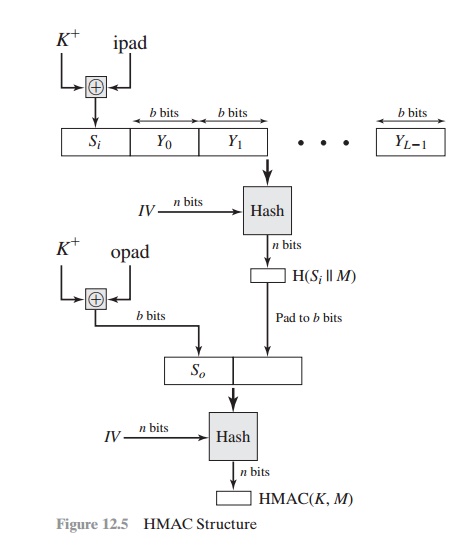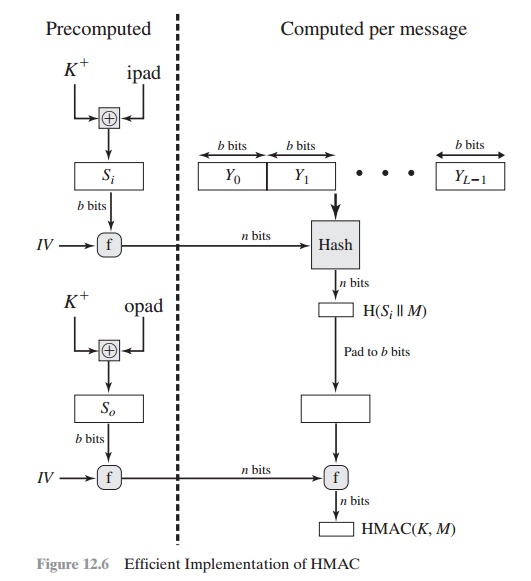Chapter: Cryptography and Network Security Principles and Practice : Cryptographic Data Integrity Algorithms : Message Authentication Codes
MACS Based on Hash Functions: HMAC
MACS
BASED ON HASH FUNCTIONS: HMAC
Later in this chapter, we look at examples of a MAC based on the use of a symmet- ric
block cipher. This has traditionally been the most common approach to constructing a MAC. In recent years, there has been increased interest
in developing a MAC derived
from a cryptographic hash function. The motivations for this interest are
1.
Cryptographic hash functions such as MD5 and SHA generally execute
faster in software than symmetric block ciphers such as DES.
2.
Library code for cryptographic hash functions is widely available.
With the development of AES and the more
widespread availability of code for encryption algorithms, these considerations are less significant, but hash-based MACs continue to be widely used.
A hash function
such as SHA was not designed for use as a MAC and cannot
be used directly for that purpose, because
it does not rely on a secret
key. There have been a
number of proposals for the incorporation of a secret key into an existing hash algorithm. The approach that has received the
most support is HMAC [BELL96a, BELL96b]. HMAC has
been issued as RFC 2104,
has been chosen
as the
mandatory-to-implement MAC for IP security, and is used in other Internet
proto- cols, such as SSL. HMAC has also been issued
as a NIST standard (FIPS
198).
HMAC Design Objectives
RFC 2104 lists the following design
objectives for HMAC.
•
To
use, without modifications, available
hash functions. In particular, to use hash functions that perform well in
software and for which code is freely and widely available.
•
To
allow for easy replaceability of the
embedded hash function in case faster
or more secure hash functions
are found or required.
•
To preserve the original performance of the hash function without
incurring a significant degradation.
•
To use and handle keys in a simple way.
•
To
have a well understood
cryptographic analysis of the strength of the authentication mechanism
based on reasonable assumptions about
the embedded hash function.
The first two objectives are important to the acceptability of
HMAC. HMAC treats the hash function as a “black box.” This has two
benefits. First, an existing implementation of
a hash function can be used
as a module in implementing HMAC. In this way, the
bulk of the HMAC code is prepackaged
and ready to use without modification. Second,
if it is ever desired
to replace a given hash function in an HMAC implementation, all that is required is to remove the existing
hash func- tion module and
drop in the new module. This could
be done if a faster hash func- tion were desired. More important, if the
security of the embedded hash function were compromised, the security of HMAC
could be retained simply by replacing the embedded hash function with a more
secure one (e.g., replacing SHA-2 with SHA-3).
The last design objective in the preceding
list is, in fact,
the main advantage
of HMAC over other proposed hash-based schemes. HMAC can be proven secure
provided that the embedded
hash function has some reasonable cryptographic strengths. We return to this point later in this section,
but first we examine the struc-
ture of HMAC.
HMAC Algorithm
Figure 12.5 illustrates the overall
operation of HMAC. Define the
following terms. H = embedded hash function (e.g.,
MD5, SHA-1, RIPEMD-160)
IV = initial value
input to hash function
M
= message input to HMAC (including the
padding specified in the embed- ded hash function)
Yi = i th block of M,0 Š i Š (L – 1)
L = number of blocks in M
b
= number
of bits in a block
n
= length
of hash code produced by embedded hash function
K
= secret key; recommended length is Š n; if key length is greater than b, the key is input to the hash function to produce an n-bit key

K+ = K padded with zeros on the left so that the result is b bits in length ipad = 00110110 (36 in
hexadecimal) repeated b/8 times
opad = 01011100 (5C in hexadecimal) repeated
b/8 times Then HMAC can
be expressed as
HMAC(K, M) = H[(K+ Ⓧ opad) || H[(K+ Ⓧ ipad) || M]]
We can describe the algorithm as follows.
1.
Append zeros to the
left end of K to create a b-bit string K+ (e.g., if
K is of length 160 bits and b = 512, then K will be appended with 44 zeroes).
2.
XOR (bitwise exclusive-OR) K+ with ipad to produce
the b-bit block Si.
3.
Append M to Si.
4.
Apply H to the stream
generated in step 3.
5.
XOR K+ with opad to produce
the b-bit block So.
6.
Append the hash result
from step 4 to So.
7.
Apply H to the
stream generated in step 6 and output the result.
Note that the XOR with ipad results in flipping one-half of the bits of
K. Similarly, the XOR with opad results
in flipping one-half
of the bits of K, using
a dif- ferent set of bits. In effect, by passing Si and So through the compression function
of the hash algorithm, we have pseudorandomly generated two keys from K.
HMAC should execute
in approximately the same time as the embedded hash function for long messages. HMAC adds three executions of the hash compression
function (for Si, So, and the block
produced from the inner hash).
A more efficient implementation is possible, as shown in
Figure 12.6. Two
quantities are precomputed:
f(IV, (K
+ Ⓧ ipad))
f(IV, (K
+ Ⓧ opad))
where f(cv, block) is the compression function
for the hash function, which
takes as arguments a chaining variable
of n bits and a block
of b bits and produces a chaining
variable of n bits. These
quantities only need to be computed initially and every time the
key changes. In effect, the precomputed quantities substitute for the initial value
(IV) in the hash function. With
this implementation, only one additional instance of the compression function is added
to the processing normally produced
by the hash function. This more efficient implementation is especially worthwhile if most of the
messages for which a MAC is computed are short.
Security of HMAC
The security of any MAC function based on an embedded hash function depends in some
way on the cryptographic strength of the underlying hash function. The appeal of HMAC is that its designers have been able to prove
an exact relationship between the strength of the
embedded hash function and the strength of
HMAC.

The security of a MAC function
is generally expressed in terms of the probability of successful forgery with
a given amount of time spent by the forger and a given number of message–tag
pairs created with the same key. In essence, it is proved in
[BELL96a] that for a given level of effort (time, message–tag pairs) on
messages generated by a legitimate user and seen by the attacker, the probability of successful attack on HMAC is equivalent
to one of the following attacks on the embedded
hash function.
1.
The attacker is able to compute
an output of the compression function even with an IV that is random, secret,
and unknown to the attacker.
2.
The attacker finds collisions in the hash function even when the IV is random and secret.
In the first attack, we can view the
compression function as equivalent to the
hash function applied to a message consisting of a single
b-bit block. For this attack, the IV of the hash function is replaced by a secret,
random value of n bits.
An attack on this hash function
requires either a brute-force attack
on the key, which
is a level of effort on the order
of 2n, or a birthday attack,
which is a special case of the second
attack, discussed next.
In
the
second attack, the attacker is looking for two messages M and M¿ that produce the same hash: H(M) = H(M¿). This is the birthday attack discussed in Chapter 11. We have shown that this requires a level of effort
of 2n/2 for a hash length
of n. On this basis, the security of
MD5 is called into question, because a level of effort of 264 looks feasible with
today’s technology. Does this mean that a 128-bit hash function such as MD5 is
unsuitable for HMAC? The answer is no, because of the following argument. To attack MD5, the attacker can choose any
set of messages and work on these off line
on a dedicated computing facility to
find a collision. Because the attacker knows the hash algorithm and the
default IV, the attacker can generate the
hash code for each of
the messages
that the attacker generates.
However, when attacking HMAC, the
attacker cannot generate message/code pairs off line because the attacker does
not know K. Therefore, the attacker
must observe a sequence of messages
generated by HMAC under the same key
and perform the attack on these known messages. For a hash code length of 128 bits,
this requires 264 observed blocks (272 bits) generated using the same key.
On a 1-Gbps link, one would need to observe a continuous
stream of messages with no change in key for about 150,000 years in order to
succeed. Thus, if speed is a concern,
it is fully accept- able to use MD5 rather than SHA-1 as the embedded hash function for HMAC.
Related Topics